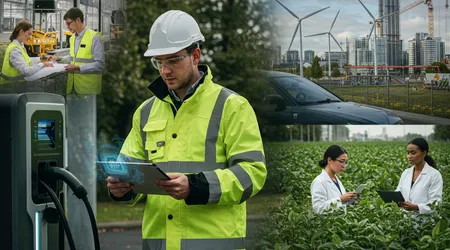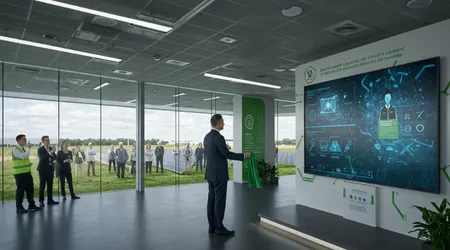Government Launches AI Growth Zones and Green Jobs Training

Government Launches AI Growth Zones to spark economic revival, pairing them with 18,000 new green jobs training places to drive sustainable prosperity.
Announced in early 2025, this ambitious dual strategy targets innovation and employment in high-growth sectors.
By creating dedicated AI hubs and equipping workers with eco-friendly skills, the UK aims to cement its global leadership in technology and sustainability.
This isn’t just policy it’s a vision for a future where tech and green economies thrive together. Can Britain seize this moment to redefine its industrial landscape?
The initiative, rooted in the AI Opportunities Action Plan, responds to a pressing need: harnessing AI’s potential while addressing environmental challenges.
Culham, Oxfordshire, hosts the first AI Growth Zone, leveraging its fusion energy expertise.
Meanwhile, green jobs training focuses on renewable energy and sustainable construction, aligning with the UK’s 2030 clean power goal.
This article unpacks the strategy’s implications, blending sharp analysis with real-world examples to show why this matters.
AI Growth Zones: Catalysts for Economic Transformation
Government Launches AI Growth Zones to fast-track AI infrastructure, targeting deindustrialised regions hungry for revival.
Culham’s zone, backed by a £14 billion private investment, will create 13,250 jobs.
These hubs streamline planning and boost power access, enabling data centres to flourish. Imagine a shuttered factory in the North East reborn as a buzzing AI hub local economies could soar.
The strategy prioritizes sites with robust energy connections, like those near wind farms. Scotland and Wales, rich in renewables, are prime candidates.
By 2030, public compute capacity will expand 20-fold, per the government’s plan. This isn’t just about tech it’s about breathing life into forgotten communities.
Picture a Teesside welder now coding AI algorithms: transformation starts here.
++ MPs Launch Inquiry into Outside Interests: A Step Toward Restoring Public Trust
Yet, challenges loom. Power constraints could stall progress, as data centres demand vast energy. The AI Energy Council, co-chaired by ministers, aims to solve this.
Will streamlined planning outpace grid limitations?
Regions must compete fiercely to secure zones, balancing ambition with feasibility. The bidding process, open until February 2025, will test local authorities’ vision.

Green Jobs Training: Building a Sustainable Workforce
The Government Launches AI Growth Zones alongside 18,000 green jobs training places, targeting skills for a net-zero future.
Renewable energy, sustainable construction, and energy efficiency dominate the curriculum.
Read more: London Aims to Host 2040 Olympics: A Bold Vision for History
Training aligns with the 2030 clean power target, ensuring workers drive the green transition. A Liverpool apprentice learning solar panel installation exemplifies this shift.
| Sector | Training Places | Key Skills |
|---|---|---|
| Renewable Energy | 8,000 | Solar, wind turbine maintenance |
| Sustainable Construction | 6,000 | Green building techniques |
| Energy Efficiency | 4,000 | Insulation, smart grid systems |
The International Monetary Fund estimates AI and green tech could boost UK GDP by £47 billion annually.
Training programs, delivered via local colleges, prioritize accessibility. For instance, a redundant steelworker in Wales could retrain as a wind turbine technician.
This isn’t just upskilling it’s economic empowerment.
Also read: England Prepares for Pivotal Local Elections That Could Reshape Party Politics
However, scaling training demands coordination. Colleges need funding, and employers must align with curricula.
The government’s Industrial Strategy, due in Spring 2025, will clarify support. Without swift action, skill shortages could bottleneck green growth.
Regions like the North West, with strong renewable potential, must seize this opportunity to lead.
Synergy Between AI and Green Economies

The Government Launches AI Growth Zones to complement green jobs training, creating a symbiotic tech-green ecosystem.
AI optimizes renewable energy grids, enhancing efficiency. Green jobs, in turn, power AI data centres with clean energy. A Scottish wind farm supplying a nearby AI hub illustrates this synergy.
AI-driven analytics can predict energy demand, reducing waste. Green-trained workers maintain the infrastructure, ensuring sustainability.
The Culham zone, tied to fusion research, exemplifies this blend. By 2026, it could host a 500MW data centre powered by clean energy. This isn’t sci-fi it’s the UK’s future.
Still, integration isn’t seamless. AI’s energy hunger clashes with green goals. The AI Energy Council must innovate to balance demands.
Regions like the North East, with deindustrialised sites, could merge AI hubs with green training centres. Without bold execution, this synergy risks remaining theoretical.
Challenges and Opportunities Ahead
The Government Launches AI Growth Zones with fanfare, but power and planning hurdles threaten progress.
Data centres need 500MW+ capacity, straining grids. The National Energy System Operator must prioritize upgrades.
A North West mayor pitching a zone without grid access risks rejection.
Training faces similar hurdles. The 18,000 places sound impressive, but demand exceeds supply. The Construction Industry Training Board reported a 2024 skills gap of 250,000 workers.
Bridging this requires private sector buy-in. A Leeds firm partnering with colleges to train green builders shows what’s possible.
Opportunities abound, though. AI zones could attract global tech giants, boosting investment. Green training positions the UK as a clean energy leader.
Picture a redundant miner in Durham now installing solar panels local pride restored. The Government Launches AI Growth Zones to spark this change, but execution is key.
Global Context: Can the UK Compete?
The Government Launches AI Growth Zones to rival global AI powerhouses, but competition is fierce.
The US’s $500 billion Stargate Project dwarfs the UK’s £14 billion. France’s €110 billion AI investment, announced in Paris, sets a high bar.
Can the UK’s targeted approach outshine these giants?
The UK’s strength lies in precision. Culham’s fusion expertise and green training focus give it an edge. Unlike sprawling US plans, the UK targets deindustrialised regions, maximizing impact.
A Welsh data centre powered by local wind farms could outshine a generic US facility. Strategic focus is the UK’s trump card.
Still, global talent wars loom. AI experts and green engineers are in demand.
The Government Launches AI Growth Zones to attract professionals, but visa policies must align. Singapore’s AI skills programs offer a model can the UK match this agility? The race is on.
A Vision for Inclusive Growth

The Government Launches AI Growth Zones to ensure no region is left behind. Deindustrialised areas, often neglected, stand to gain most.
The North East’s high unemployment makes it a prime candidate. A redundant shipyard worker retraining for AI coding embodies this hope.
Green training extends this inclusivity. Programs target diverse groups, from young apprentices to mid-career switchers.
A Manchester single mother learning energy efficiency skills could transform her family’s future.
This isn’t just policy it’s a social contract. The government’s Local Growth Plans, due in 2025, will solidify this commitment.
Yet, inclusivity demands outreach. Rural areas risk missing out without mobile training units. The Government Launches AI Growth Zones to unify the nation, but logistics matter.
A Cumbrian village hosting a green skills workshop shows how to bridge this gap. Execution must match ambition.
Conclusion: A Defining Moment for the UK
The Government Launches AI Growth Zones and green jobs training to redefine the UK’s economic and environmental future.
This dual strategy marries innovation with sustainability, targeting 13,250 AI jobs and 18,000 green training places.
It’s a bold bet on tech and clean energy, rooted in real-world needs. From Culham’s data centre to a Welsh wind turbine technician, the vision is clear: prosperity through progress.
But boldness requires grit. Power constraints, skills gaps, and global competition demand relentless focus. The UK stands at a crossroads will it lead or follow?
By blending AI’s potential with green ambition, it can forge a path others envy. The journey starts now, and every region has a stake.
Frequently Asked Questions
What are AI Growth Zones?
They’re designated areas with streamlined planning and power access to boost AI infrastructure, creating jobs and investment. Culham, Oxfordshire, hosts the first.
How do green jobs training programs work?
They offer 18,000 places in renewable energy, construction, and efficiency skills, delivered via colleges, targeting net-zero goals by 2030.
Who can apply for AI Growth Zone status?
Local authorities and industry can bid until February 2025, prioritizing sites with strong energy connections or redevelopment potential.
What’s the economic impact?
The IMF estimates AI and green tech could add £47 billion annually to the UK economy, with 13,250 AI jobs created.
How does this support deindustrialised areas?
Zones and training target regions like the North East, reviving local economies through high-skill jobs and investment.
